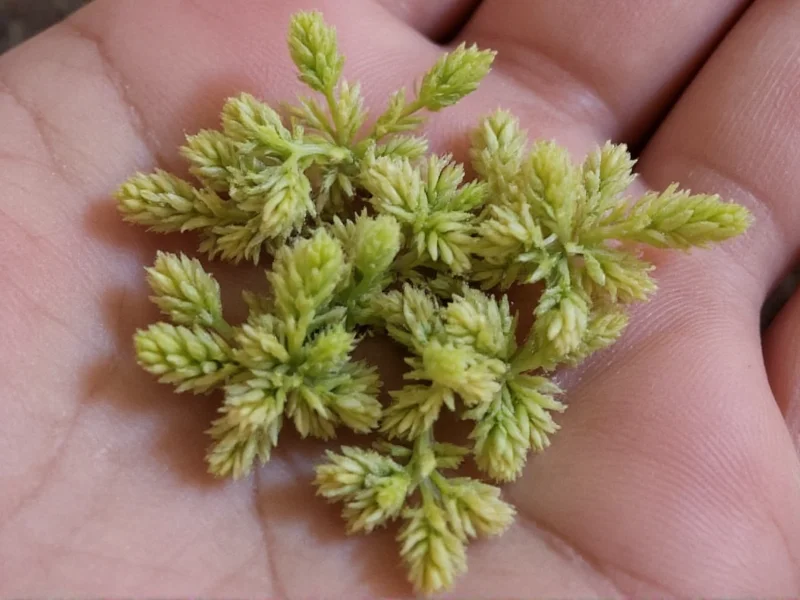Dillweed is a term that often causes confusion due to its spelling and the common slang usage of “weed.” Understanding what dillweed actually is requires clarifying botanical terminology and addressing common misconceptions.
Botanical Identity of Dillweed
The term “dillweed” technically refers to the feathery green leaves of the dill plant (Anethum graveolens), which belongs to the Apiaceae family alongside parsley, celery, and cilantro. When you see “dillweed” listed in recipes or on spice labels, it specifically means the dried foliage of the dill plant, not the seeds.
What many people don't realize is that “dillweed” is actually a misnomer in formal botanical contexts. The correct term is “dill weed” (two words), with “weed” in this case deriving from an old English word meaning “plant” or “herb,” not the modern slang for marijuana. This linguistic confusion has led to persistent misunderstandings about what dillweed actually is.
Dillweed vs. Dill Seeds: Understanding the Difference
Many home cooks don't realize that dillweed and dill seeds come from the same plant but offer distinctly different flavor profiles and culinary applications:
| Characteristic | Dillweed (Leaves) | Dill Seeds |
|---|---|---|
| Flavor Profile | Fresh, grassy, delicate anise notes | Stronger, earthier, more pungent with caraway-like notes |
| Best Used In | Fish dishes, salads, dressings, sour cream sauces | Pickling, breads, stews, spice blends |
| Harvest Time | Before flowering (late spring to early summer) | After flowering, when seeds mature (late summer) |
| Storage Life | 6-12 months dried, longer frozen | 2-3 years in airtight container |
Common Misconceptions About Dillweed
One of the most persistent myths surrounding dillweed is its supposed connection to marijuana. This confusion stems entirely from the word “weed” in its name. In reality, dillweed has absolutely no relation to cannabis. The term “weed” in “dill weed” comes from the Old English “weda,” meaning “plant” or “herb,” not the modern slang term.
Another misconception is that dillweed is a different plant species from regular dill. In fact, it's simply the leafy portion of the same Anethum graveolens plant that produces dill seeds. Understanding what is dillweed in cooking contexts helps prevent recipe errors when substitutions might be necessary.
Culinary Applications of Dillweed
Dillweed's delicate flavor makes it particularly valuable in dishes where you want herbaceous notes without overpowering other ingredients. Professional chefs often prefer fresh dillweed for Scandinavian dishes, particularly gravlax and other cured fish preparations.
When working with dried dillweed (what many grocery stores label simply as “dillweed”), remember that dried herbs are more concentrated than fresh. The general conversion is:
- 1 tablespoon fresh dillweed = 1 teaspoon dried dillweed
- Dried dillweed should be added earlier in cooking than fresh to allow flavors to infuse
- Fresh dillweed is best added at the end of cooking to preserve its delicate flavor
Growing and Harvesting Dillweed
If you're interested in growing your own dillweed, the plant is relatively easy to cultivate in most temperate climates. Dill prefers full sun and well-drained soil, and can grow up to 4 feet tall. For the best dillweed harvest:
- Harvest leaves when the plant is about 8-12 inches tall
- Cut stems in the morning after the dew has dried
- For maximum flavor, harvest before the plant flowers
- Regular harvesting encourages bushier growth
Properly dried dillweed retains much of its flavor and can be stored for up to a year in an airtight container away from light. Freezing fresh dillweed in oil or water preserves more of its fresh flavor than drying.
Health Benefits of Dillweed
While not as extensively studied as some other herbs, dillweed contains several beneficial compounds. Research suggests that dillweed health benefits may include:
- Antioxidant properties from flavonoids and monoterpenes
- Potential digestive benefits when consumed as tea
- Small amounts of calcium, iron, and vitamin C
- Traditional use for soothing upset stomachs
It's important to note that while dillweed is safe for culinary use, it should not be considered a medical treatment for any condition. Understanding what dillweed is nutritionally helps incorporate it as part of a balanced diet.
Where to Buy Quality Dillweed
When shopping for dillweed, whether fresh or dried, look for these quality indicators:
- Fresh dillweed should be vibrant green without yellowing
- Dried dillweed should have a strong, pleasant aroma (avoid musty smells)
- Purchase from reputable spice merchants who rotate stock frequently
- Consider growing your own for the freshest possible dillweed
Knowing where to buy dillweed that retains maximum flavor will significantly impact your culinary results. Specialty herb shops, farmers markets, and well-stocked grocery stores typically offer the best quality.
Conclusion
Understanding what dillweed actually is—the dried leaves of the dill plant—helps clarify common misconceptions and enhances culinary applications. Whether you're exploring how to use dillweed in recipes or simply want to understand the difference between dill and dillweed, recognizing it as a valuable culinary herb rather than something related to marijuana is essential knowledge for any home cook or gardening enthusiast.











 浙公网安备
33010002000092号
浙公网安备
33010002000092号 浙B2-20120091-4
浙B2-20120091-4